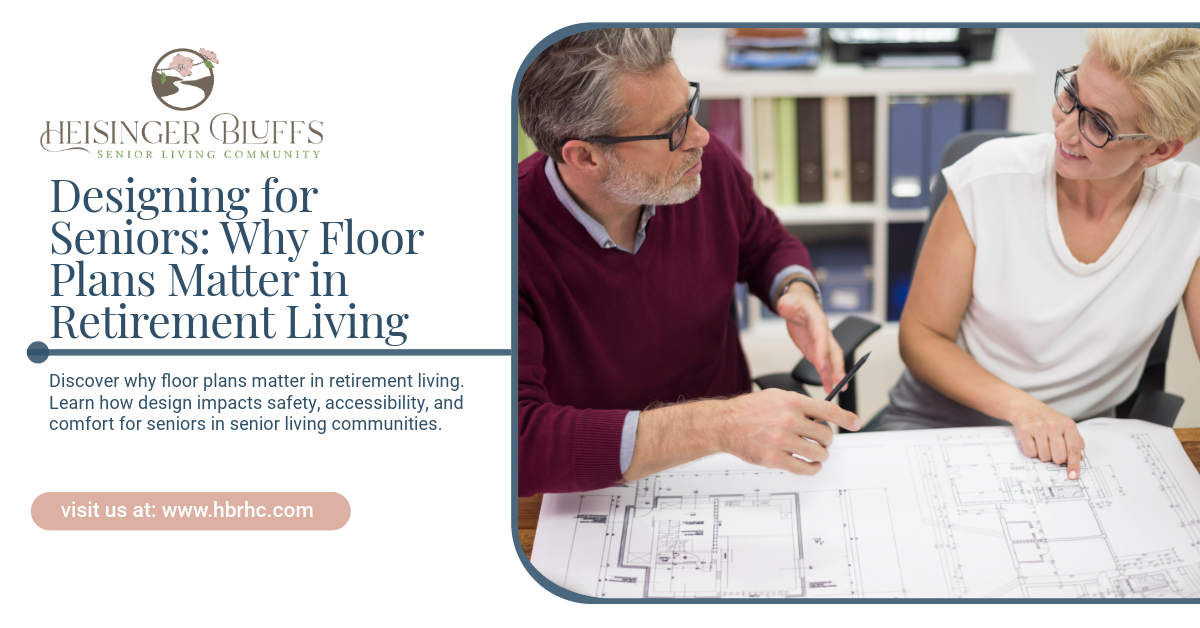Designing for Seniors: Why Floor Plans Matter in Retirement Living

Key Highlights
- Thoughtful floor plans enhance safety and accessibility for seniors.
- Open layouts and single-level designs reduce fall risks and improve mobility.
- Design elements can support independence and daily living activities.
- Adequate storage, lighting, and communal spaces improve quality of life.
- Planning floor plans with senior needs in mind fosters comfort and social engagement.
When it comes to retirement living, design matters—especially the layout and floor plan of a residence. Seniors often face mobility challenges, vision or hearing changes, and other age-related needs that make thoughtful design essential. A well-designed floor plan can improve safety, support independence, and enhance the overall quality of life for seniors.
In this blog, we’ll explore why floor plans are critical in senior living, what features make them effective, and how they contribute to both comfort and functionality.
Why Floor Plans Matter in Retirement Living
1. Safety and Fall Prevention
Falls are a leading cause of injury among seniors, making floor plan design crucial for safety. Features that minimize hazards include:
- Single-level layouts to reduce stair use
- Wide hallways for walkers or wheelchairs
- Non-slip flooring materials
- Clear sightlines to avoid obstacles
A well-thought-out layout can significantly reduce the risk of accidents, creating peace of mind for both seniors and their families.
2. Accessibility and Mobility
Accessibility is another key factor in senior living design. Floor plans should accommodate varying levels of mobility, including walkers, wheelchairs, and canes. Important design considerations include:
- Wide doorways and hallways
- Open-concept living areas
- Low-threshold entries and bathrooms
- Lever-style handles instead of knobs
These elements ensure that residents can move freely and comfortably throughout their living space.
3. Supporting Independence
A thoughtful floor plan supports seniors in maintaining independence. Clear organization, convenient placement of essential rooms, and accessible storage allow residents to perform daily activities without assistance.
For example:
- Kitchens with easy-to-reach cabinets and appliances
- Bathrooms with grab bars and roll-in showers
- Bedrooms located near bathrooms for convenience
By reducing reliance on others, seniors can enjoy dignity and autonomy in their daily lives.
4. Social Engagement and Community
Floor plans also influence social interactions. Retirement living communities often include communal areas, dining spaces, and multipurpose rooms. Proper layout encourages residents to interact, build friendships, and participate in activities, which supports emotional well-being.
Key Features of Senior-Friendly Floor Plans
| Feature | Benefit |
|---|---|
| Single-Level Living | Reduces fall risk and simplifies mobility |
| Open Concept Design | Promotes accessibility and ease of movement |
| Adequate Lighting | Improves visibility and reduces accidents |
| Non-Slip Flooring | Enhances safety, especially in kitchens and bathrooms |
| Wide Hallways and Doorways | Accommodates walkers, wheelchairs, and strollers |
| Storage Solutions | Keeps personal items organized and accessible |
| Proximity of Key Rooms | Bedrooms near bathrooms for convenience |
| Communal Spaces | Encourages social engagement and active lifestyles |
Trends in Senior Living Floor Plans
1. Flexible and Adaptable Spaces
Modern senior living communities prioritize flexible layouts that can adapt as residents’ needs change. For example, modular furniture and moveable partitions allow spaces to serve multiple purposes, from quiet reading areas to group activity rooms.
2. Incorporating Nature and Outdoor Access
Floor plans that provide easy access to outdoor spaces, patios, or walking paths encourage physical activity and connection with nature—both of which improve mental and physical health.
3. Technology Integration
Smart home features, emergency alert systems, and automated lighting are increasingly integrated into floor plans, enhancing both safety and convenience.
4. Private vs. Communal Balance
Seniors value a balance between private spaces and communal areas. Thoughtful design ensures residents have personal retreats while still encouraging engagement with neighbors and community activities.
How Floor Plans Impact Health and Well-Being
The design of a living space can influence physical, emotional, and cognitive health:
- Physical Health: Reduces falls, encourages mobility, and supports exercise routines.
- Emotional Health: Open, bright, and well-organized spaces reduce stress and create a welcoming environment.
- Cognitive Health: Clear sightlines, minimal clutter, and accessible layouts reduce confusion and support independence.
By prioritizing these factors, retirement communities can help residents maintain a high quality of life.
Choosing a Retirement Community with Smart Floor Plans
When considering a retirement community, families should evaluate floor plans carefully. Key questions to ask include:
- Are the living spaces single-level or multi-level?
- Are hallways and doorways wide enough for mobility aids?
- How accessible are bathrooms, kitchens, and bedrooms?
- Are communal areas designed to encourage social interaction?
- Is there adequate natural light and safe outdoor access?
Visiting communities and touring model units provides insight into whether the layout meets both current and future needs.
Final Thoughts
Floor plans are more than just blueprints—they shape the daily experience of seniors, influencing safety, independence, and social engagement. Thoughtful design in retirement living communities ensures seniors can live comfortably, maintain mobility, and enjoy meaningful interactions with neighbors.
At Heisinger Bluffs, we prioritize senior-friendly design in our floor plans, combining safety, accessibility, and lifestyle amenities to create a community where residents thrive. Contact us today!
Frequently Asked Questions
Why are single-level floor plans important for seniors?
Single-level floor plans reduce the risk of falls and make it easier for residents to move around safely, especially for those using mobility aids.
What makes a floor plan “senior-friendly”?
Senior-friendly floor plans focus on safety, accessibility, convenience, and opportunities for social engagement, with features like wide hallways, open layouts, and easy access to bathrooms.
How do floor plans support independence in retirement living?
By providing easy access to essential rooms, storage solutions, and safe, navigable spaces, seniors can perform daily activities with minimal assistance.
Are communal spaces important in floor plans?
Yes. Communal spaces encourage social interaction, community participation, and mental well-being among residents.
Can floor plans adapt as a senior’s needs change?
Modern senior living floor plans are often flexible, allowing residents to modify layouts, incorporate mobility aids, and integrate technology to meet evolving needs.
Sources:
- https://www.cdc.gov/falls/data-research/index.html
- https://pmc.ncbi.nlm.nih.gov/articles/PMC3570931/
- https://wlos.com/features/health-break/social-interactions-for-seniors
- https://www.nytimes.com/wirecutter/reviews/smart-home-for-seniors/
- https://www.ohio.edu/news/2024/10/five-essential-habits-maintaining-cognitive-health-you-age











